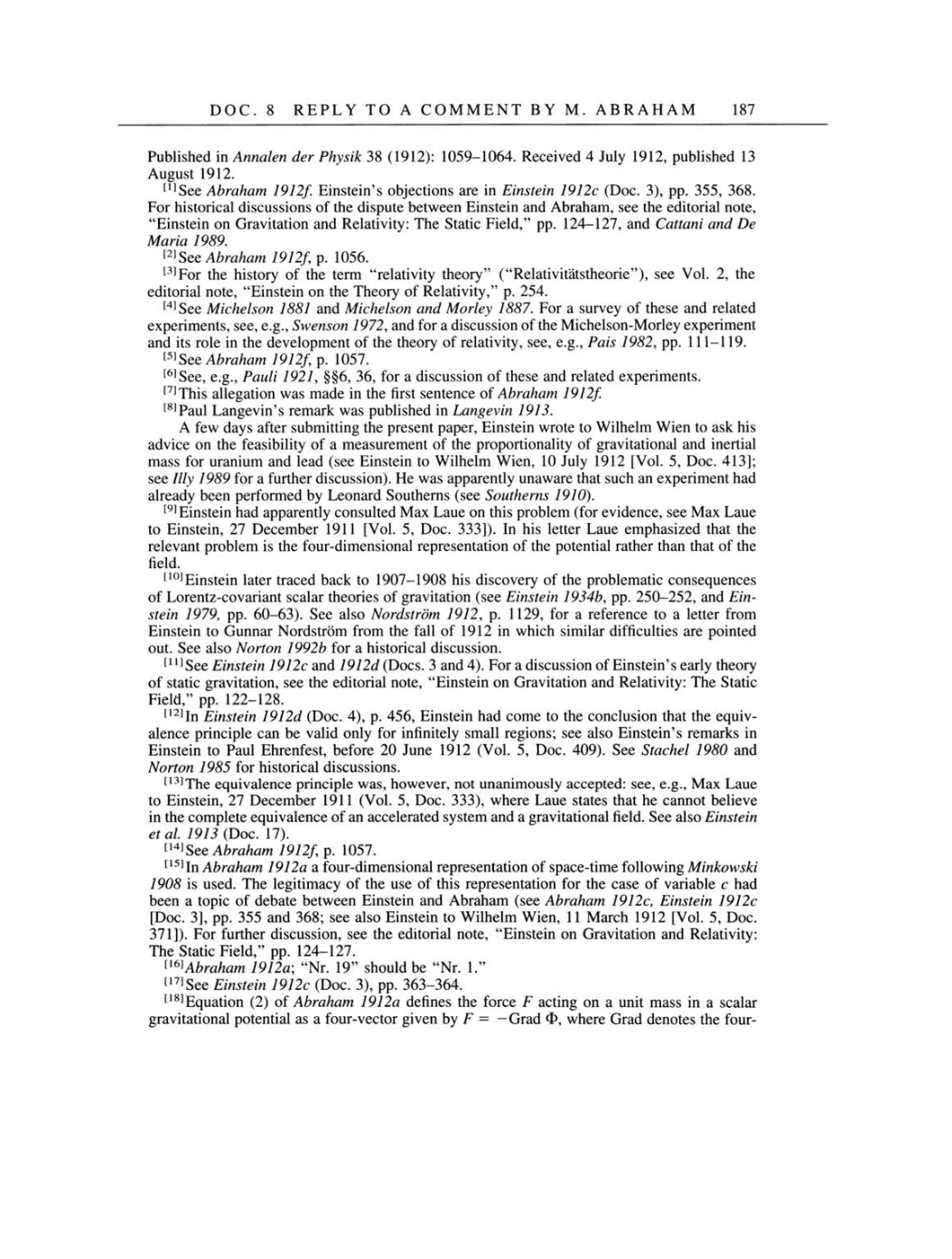DOC.
8
REPLY
TO
A
COMMENT BY M. ABRAHAM
187
Published
in
Annalen der
Physik 38 (1912):
1059-1064. Received 4
July
1912,
published
13
August
1912.
[1]See
Abraham
1912f.
Einstein's
objections are
in
Einstein
1912c
(Doc. 3), pp.
355,
368.
For historical discussions of the
dispute
between Einstein
and Abraham,
see
the editorial
note,
"Einstein
on
Gravitation and
Relativity:
The Static
Field,"
pp.
124-127, and
Cattani and De
Maria
1989.
[2]See
Abraham
1912f,
p.
1056.
[3]For
the
history
of the
term "relativity theory" ("Relativitätstheorie"),
see
Vol.
2,
the
editorial
note,
"Einstein
on
the
Theory
of
Relativity,"
p.
254.
[4]See
Michelson
1881
and Michelson and
Morley
1887.
For
a
survey
of these and related
experiments, see,
e.g.,
Swenson
1972,
and
for
a
discussion of
the
Michelson-Morley experiment
and
its role in
the
development
of
the
theory
of
relativity, see,
e.g.,
Pais
1982,
pp.
111-119.
[5]See Abraham
1912f, p.
1057.
[6]See, e.g.,
Pauli
1921,
§§6,
36,
for
a
discussion of these
and
related
experiments.
[7]This allegation
was
made
in the first sentence
of Abraham
1912f.
[8]Paul
Langevin's
remark
was
published
in
Langevin
1913.
A few
days
after
submitting
the
present paper,
Einstein
wrote to
Wilhelm Wien
to
ask
his
advice
on
the
feasibility
of
a
measurement
of the
proportionality
of
gravitational
and
inertial
mass
for uranium and lead
(see
Einstein
to
Wilhelm
Wien,
10 July
1912
[Vol. 5,
Doc. 413];
see Illy
1989
for
a
further
discussion). He
was
apparently unaware
that such
an
experiment
had
already
been
performed
by
Leonard Southerns
(see
Southerns
1910).
[9]Einstein had
apparently
consulted
Max
Laue
on
this
problem
(for evidence,
see
Max Laue
to Einstein, 27
December
1911
[Vol. 5,
Doc. 333]). In
his letter Laue
emphasized
that the
relevant
problem
is the
four-dimensional
representation
of
the
potential
rather than that of the
field.
[10]Einstein
later traced back
to
1907-1908 his
discovery
of
the
problematic consequences
of Lorentz-covariant scalar theories of
gravitation (see
Einstein
1934b, pp.
250-252,
and Ein-
stein
1979,
pp.
60-63).
See
also Nordström
1912,
p.
1129,
for
a
reference
to
a
letter
from
Einstein
to
Gunnar
Nordström from
the fall
of
1912 in
which similar difficulties
are
pointed
out. See
also Norton
1992b
for
a
historical discussion.
[11]See
Einstein 1912c and
1912d
(Docs.
3
and
4).
For
a
discussion of Einstein's
early theory
of
static gravitation,
see
the editorial
note,
"Einstein
on
Gravitation
and
Relativity:
The Static
Field,"
pp.
122-128.
[12]In
Einstein
1912d
(Doc.
4),
p.
456,
Einstein had
come
to the
conclusion that the
equiv-
alence
principle
can
be
valid
only
for
infinitely
small
regions;
see
also
Einstein's remarks
in
Einstein
to
Paul
Ehrenfest,
before
20
June
1912
(Vol. 5,
Doc.
409).
See
Stachel 1980
and
Norton
1985
for historical discussions.
[13]The
equivalence principle
was,
however,
not
unanimously
accepted:
see,
e.g.,
Max Laue
to
Einstein, 27
December
1911
(Vol. 5,
Doc.
333),
where Laue
states
that he
cannot
believe
in
the
complete equivalence
of
an
accelerated
system
and
a
gravitational
field. See
also Einstein
et
al. 1913 (Doc.
17).
[14]See
Abraham
1912f, p.
1057.
[15]In
Abraham 1912a
a
four-dimensional
representation
of
space-time following
Minkowski
1908 is used.
The
legitimacy
of
the
use
of this
representation
for the
case
of variable
c
had
been
a topic
of debate between Einstein and Abraham
(see
Abraham
1912c,
Einstein 1912c
[Doc. 3],
pp.
355
and
368;
see
also Einstein
to
Wilhelm
Wien,
11
March
1912
[Vol. 5,
Doc.
371]).
For further
discussion,
see
the editorial
note,
"Einstein
on
Gravitation
and
Relativity:
The Static
Field,"
pp.
124-127.
[16]Abraham 1912a;
"Nr.
19"
should
be
"Nr.
1."
[17]See
Einstein 1912c
(Doc. 3),
pp.
363-364.
[18]Equation
(2)
of Abraham 1912a
defines the
force F
acting
on
a
unit
mass
in
a
scalar
gravitational potential as a
four-vector
given
by
F
=
-Grad
Q,
where Grad denotes the
four–
